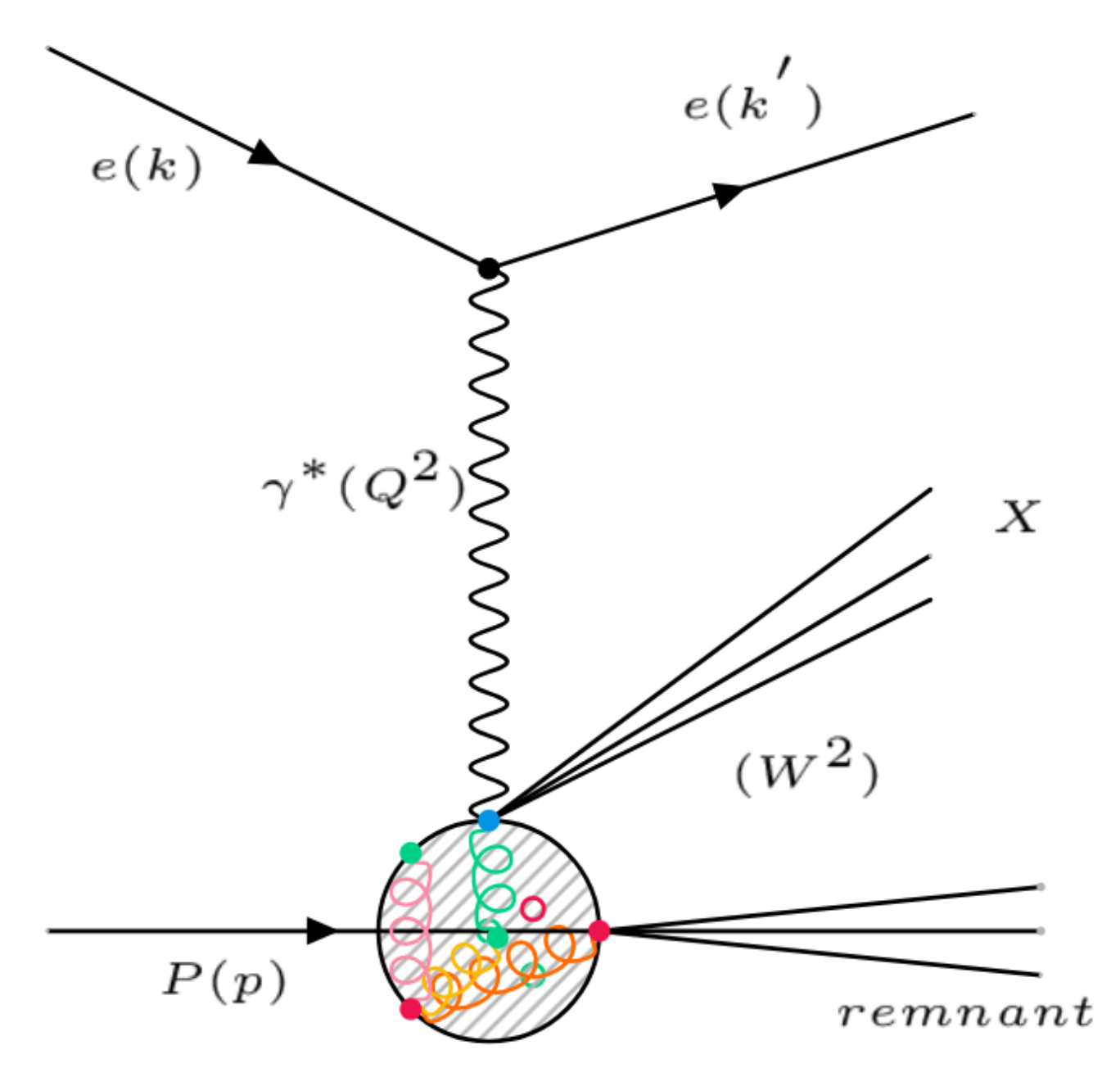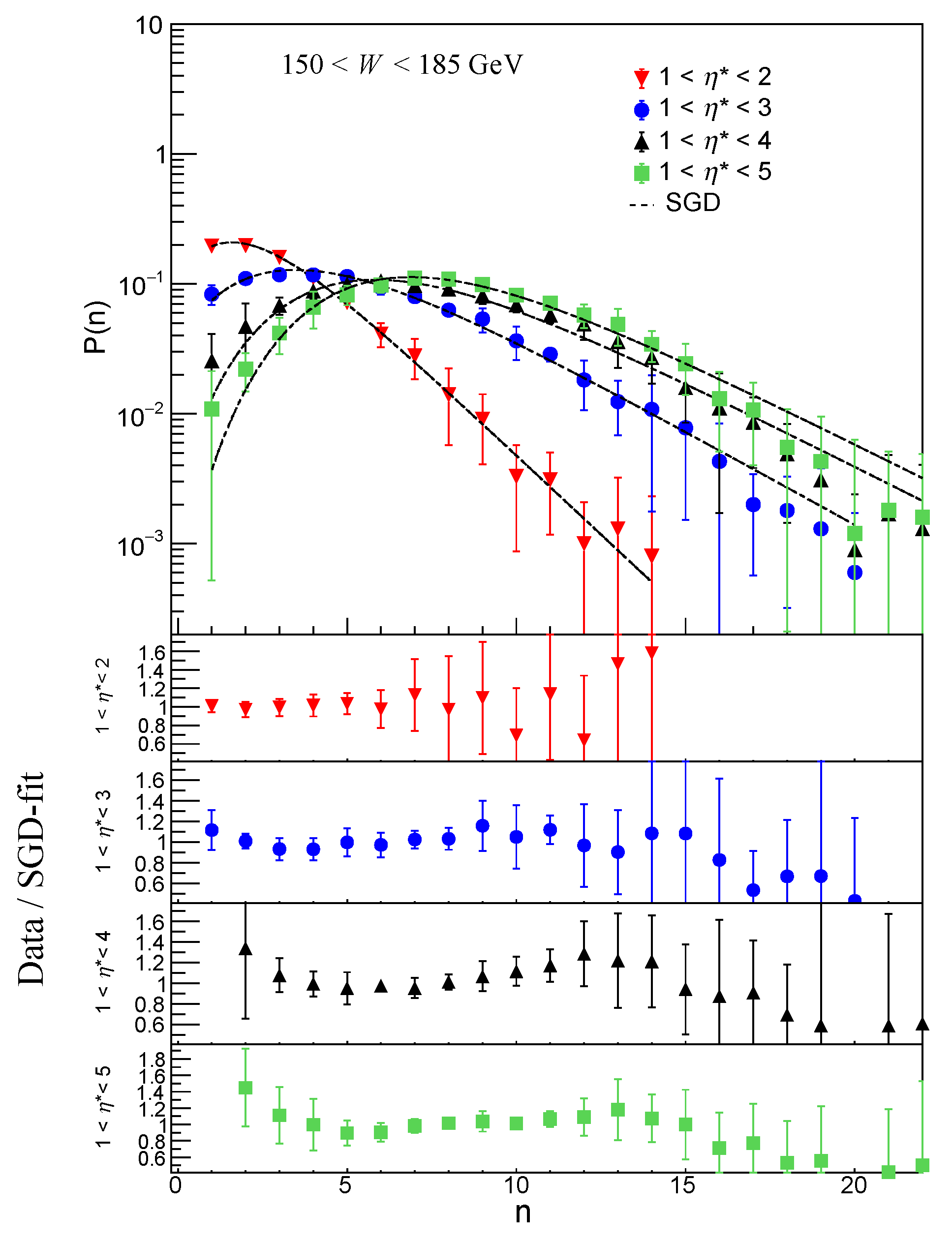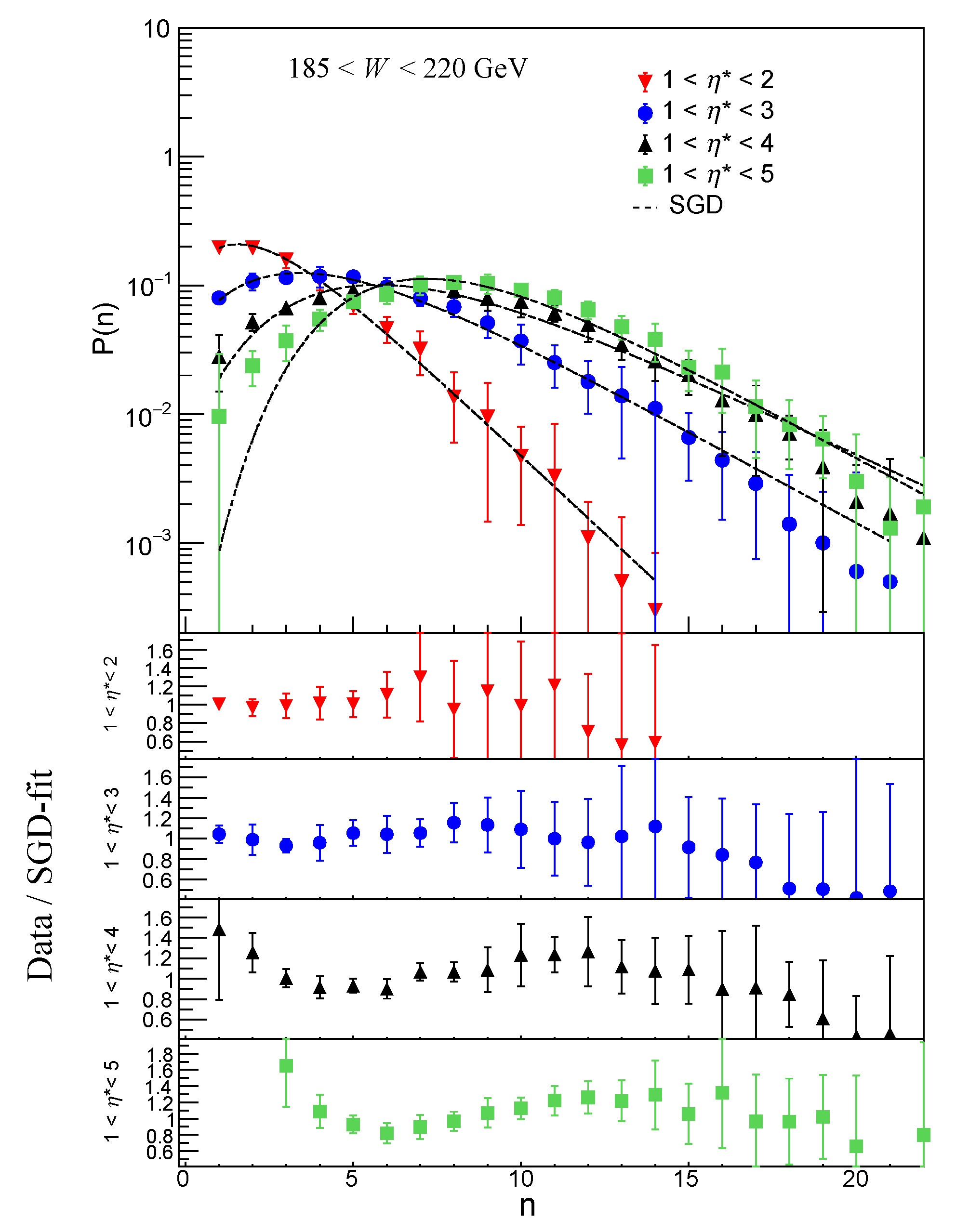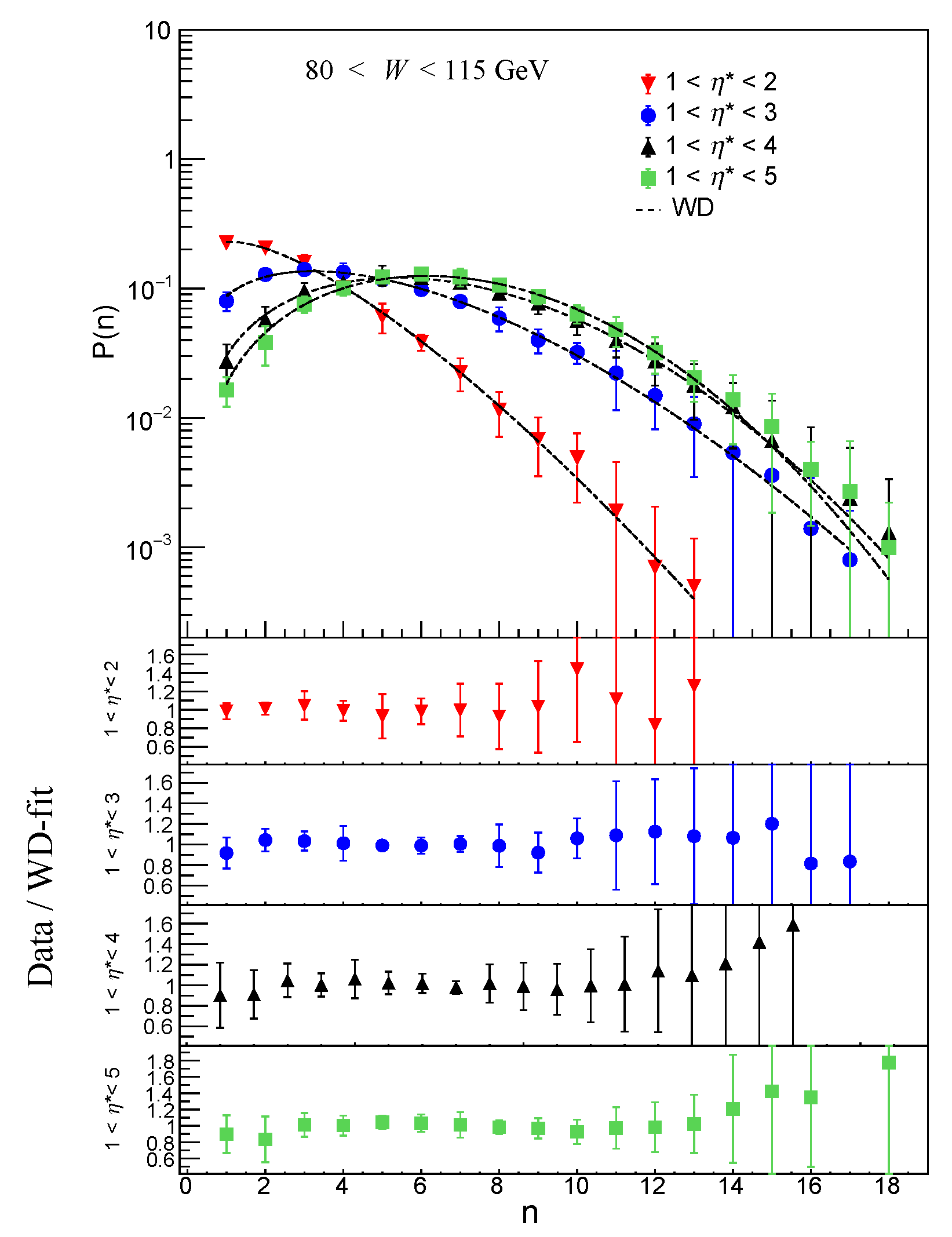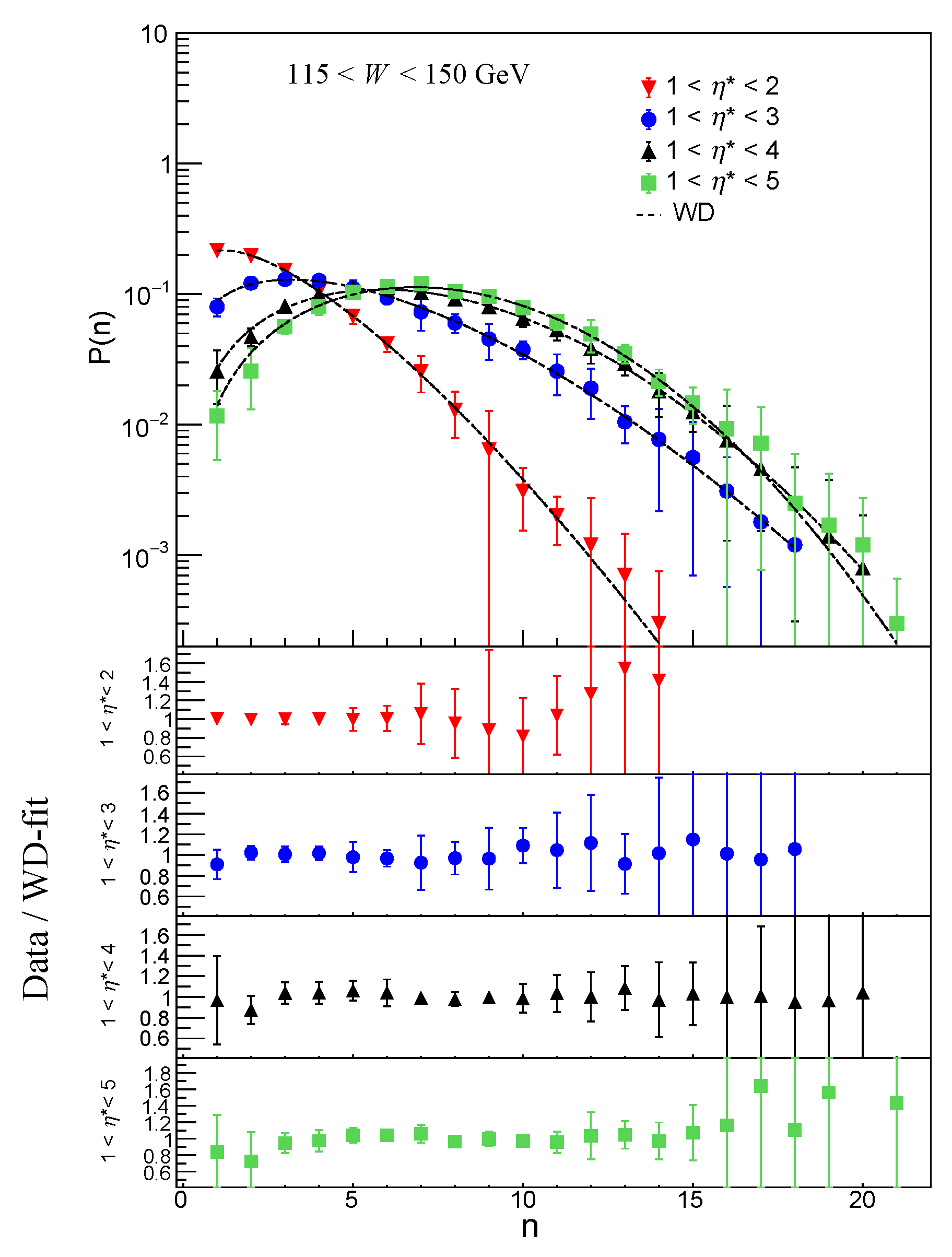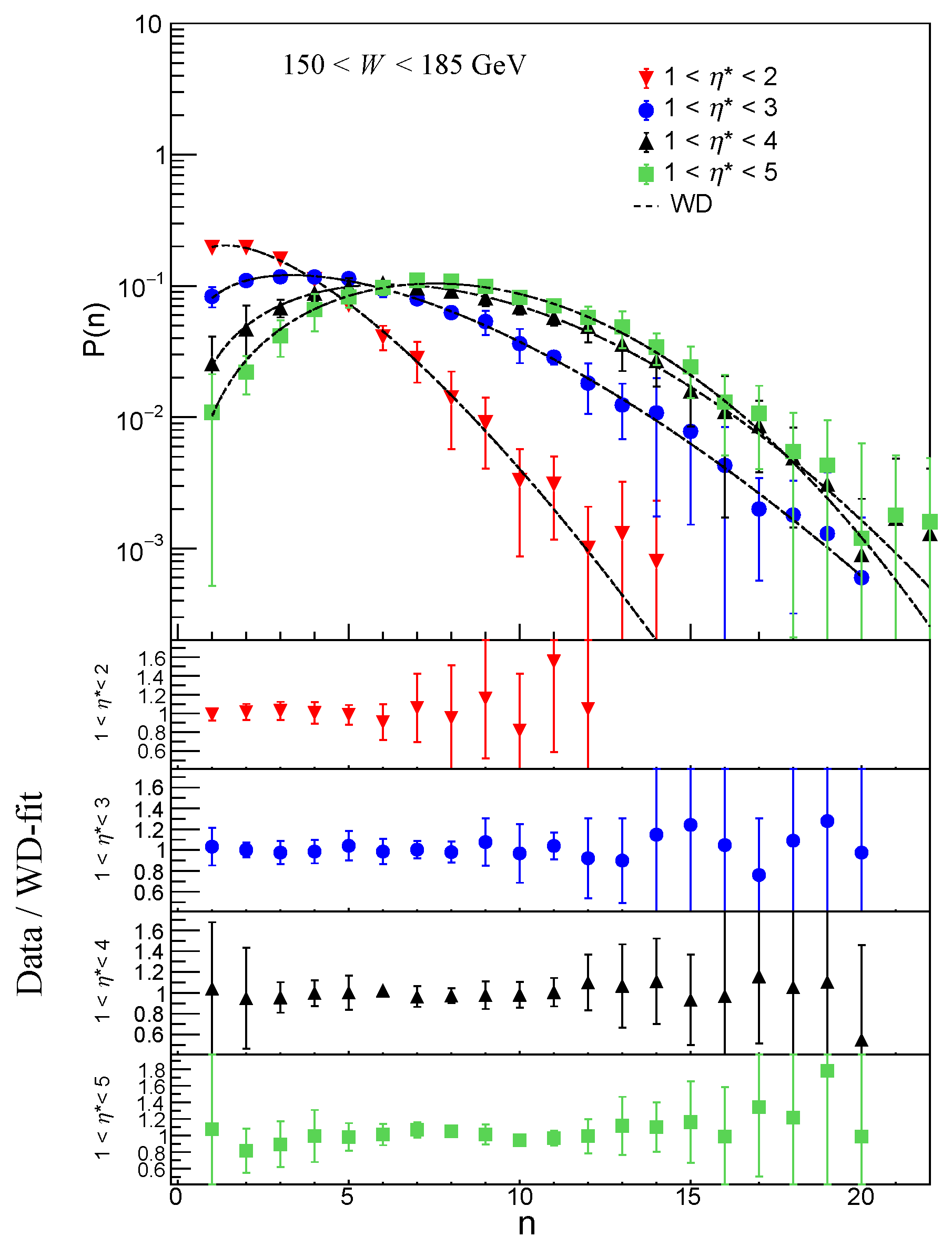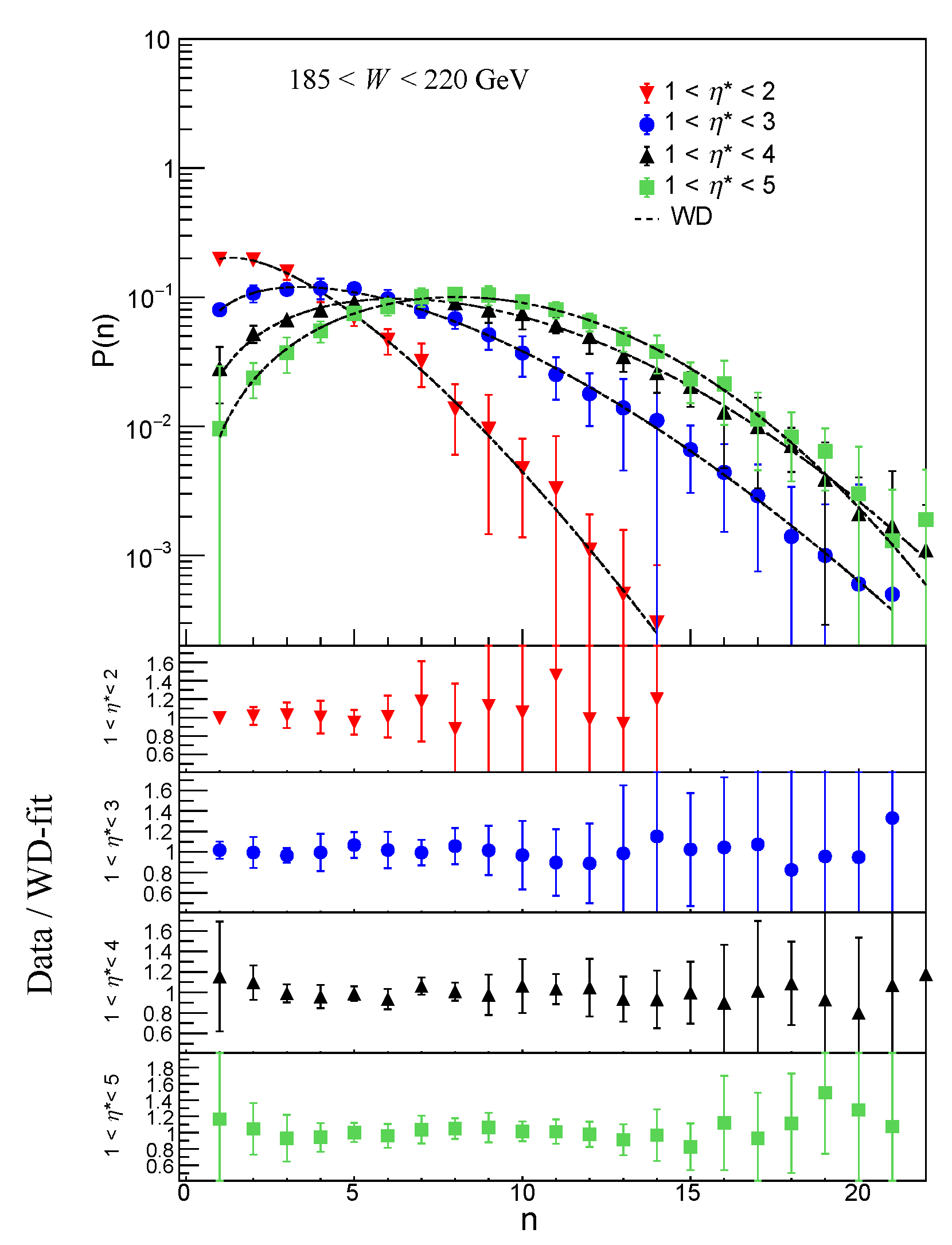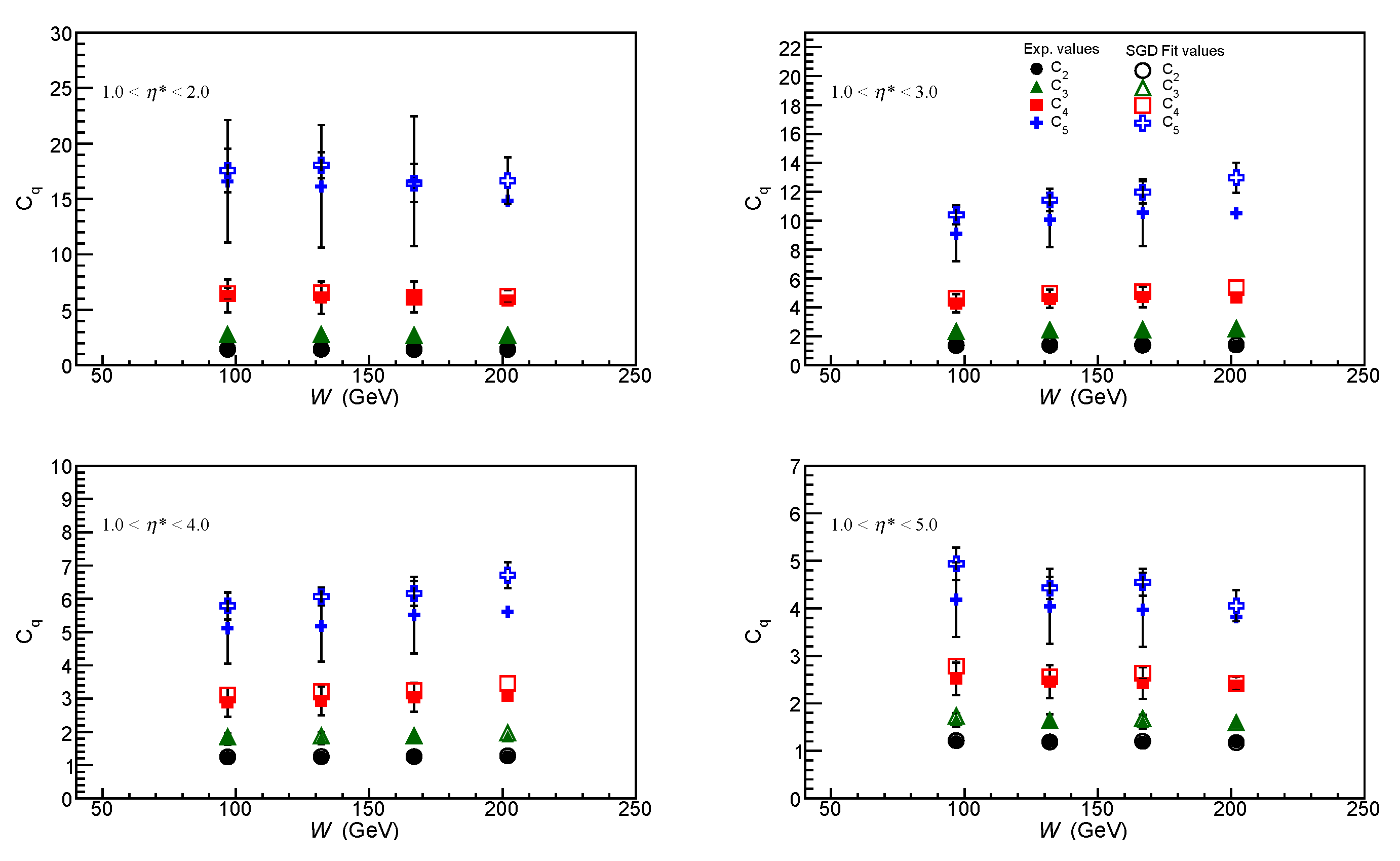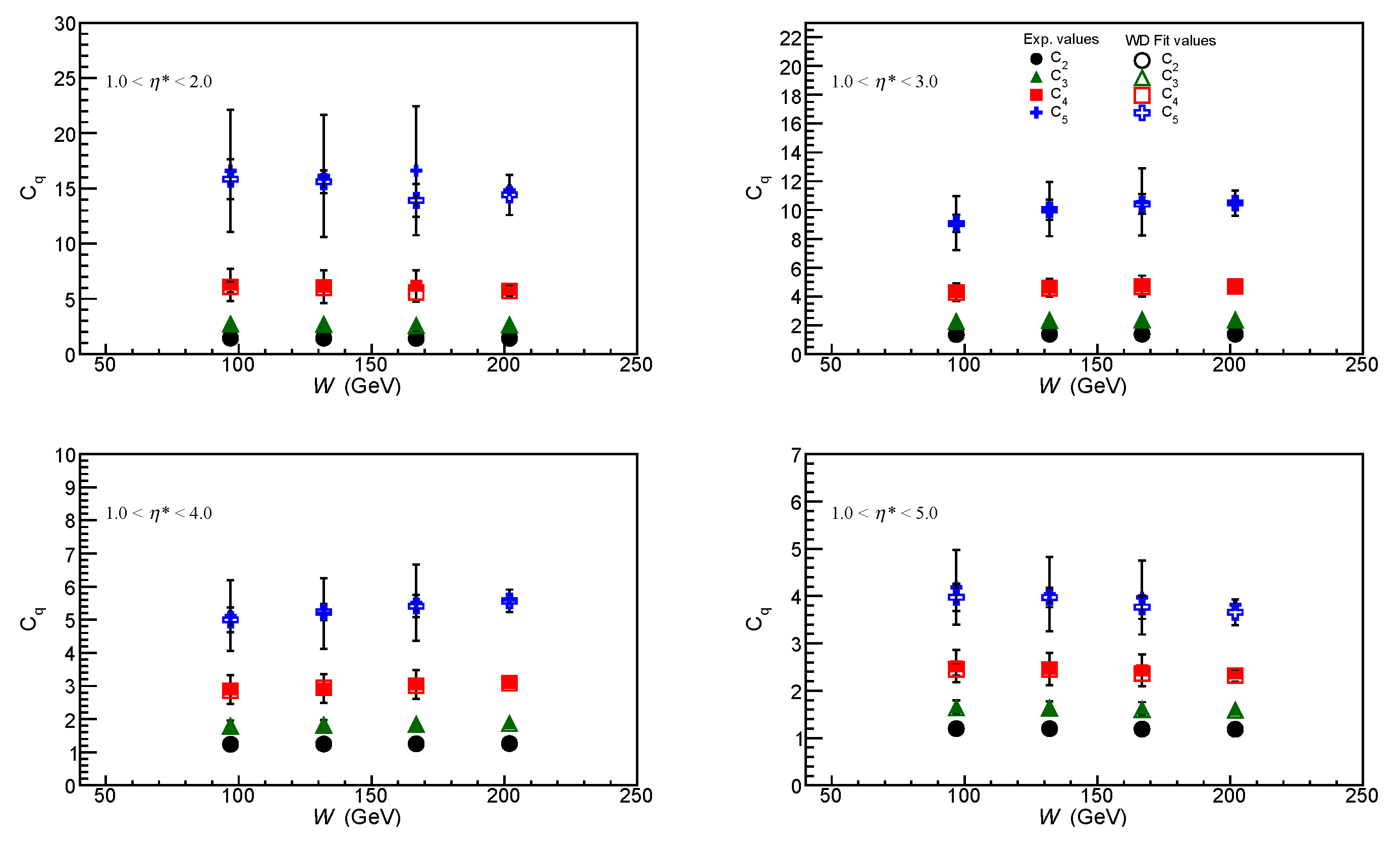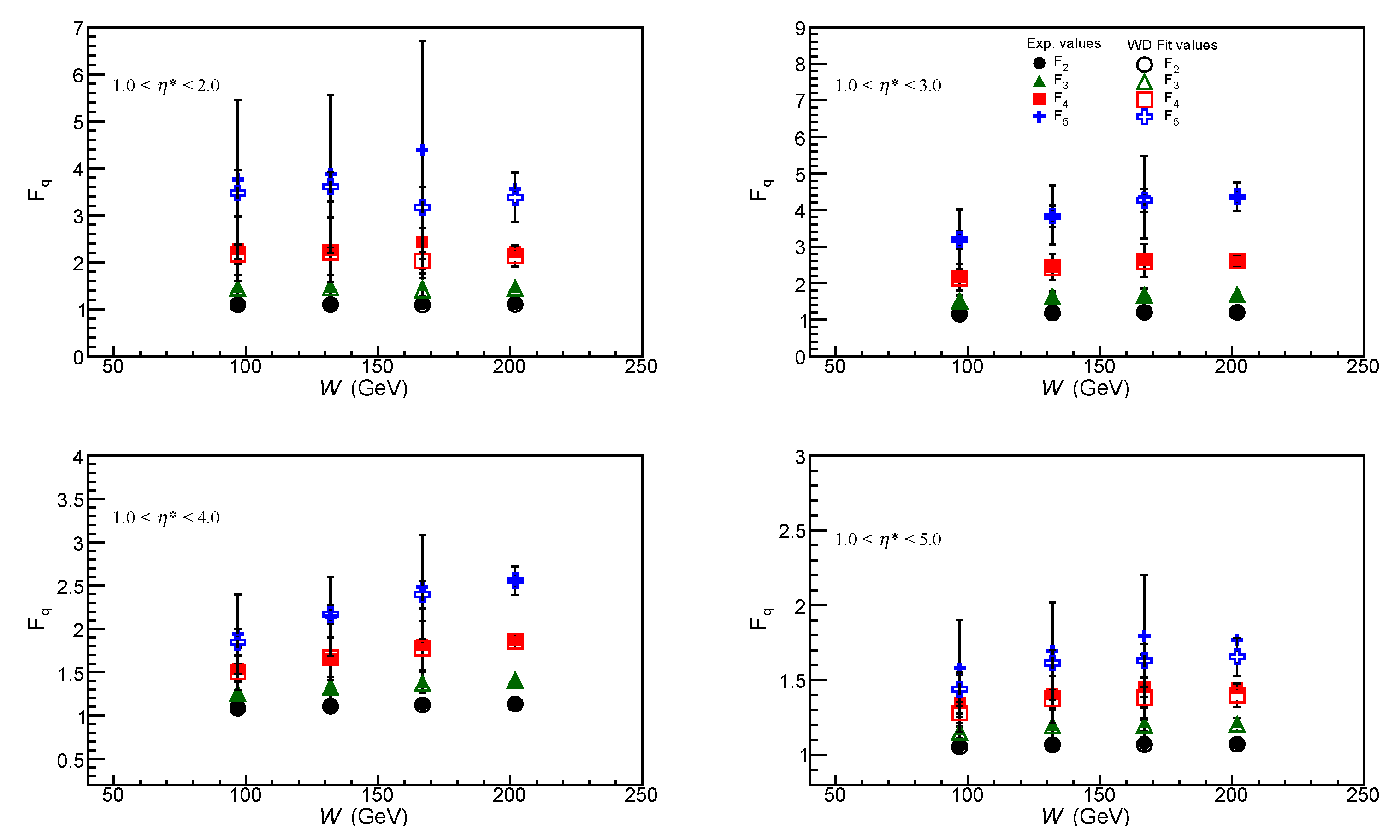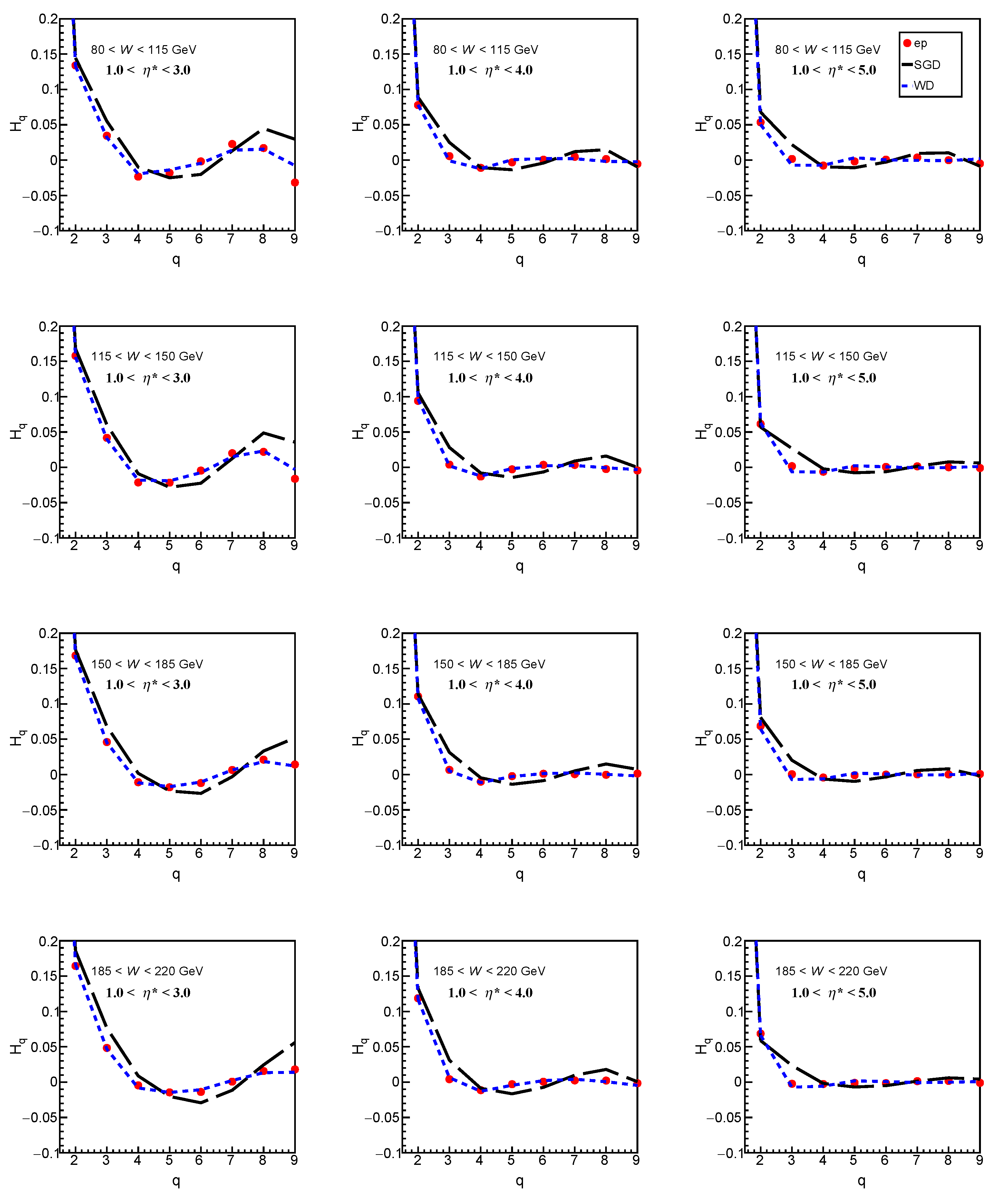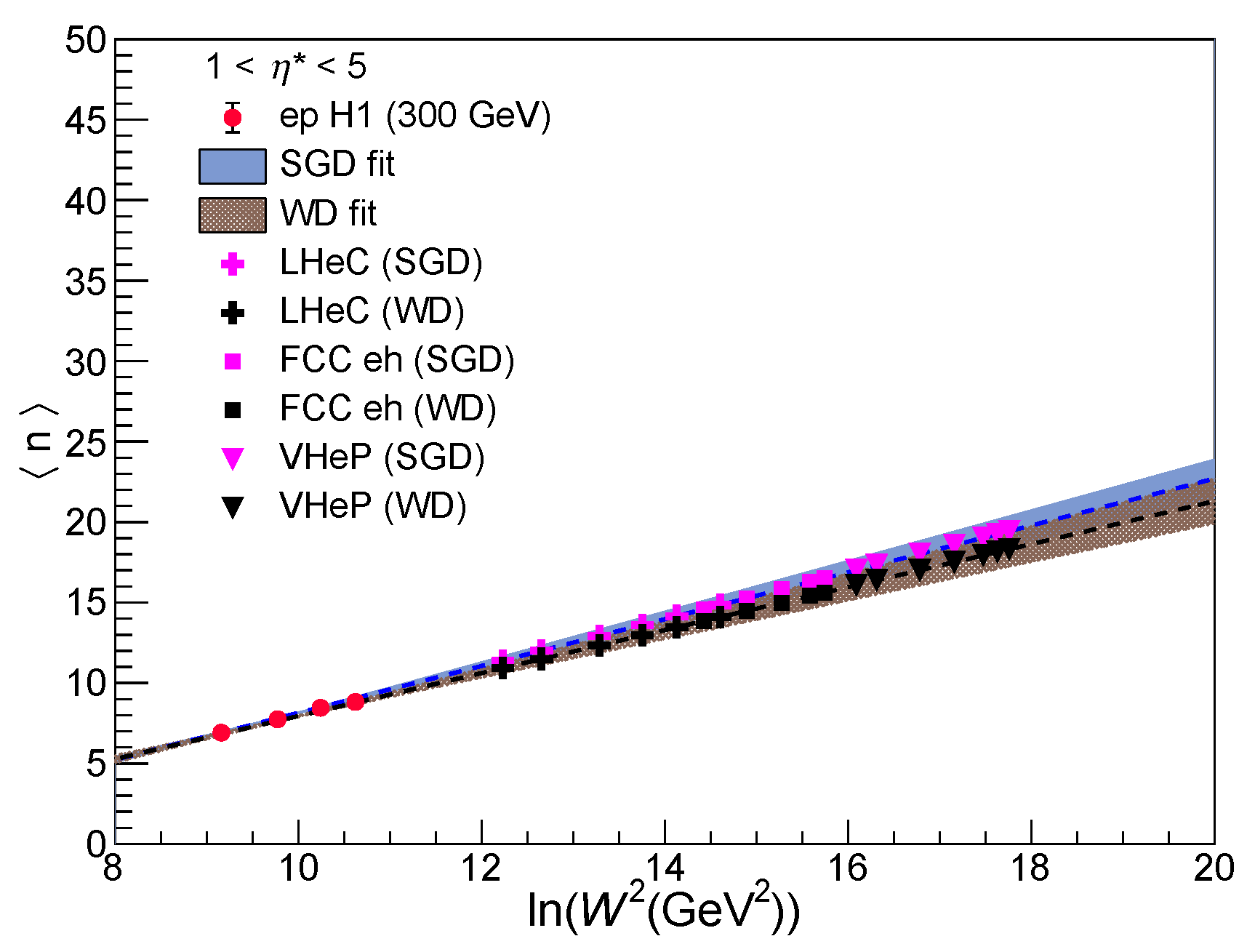1. Context and Introduction
Ever since the discovery of quarks and gluons, the search for their composites forming new particles in the form of leptons and hadrons has driven high energy physicists to strive for higher and higher energy regimes in pursuit of new exotic particles. Unprecedented and cutting edge technological developments, combined with scientific expertise have pushed the energy frontier to new levels. This made possible the discovery of Higgs boson at the Large Hadron Collider (LHC) [
1] at CERN in recent years. During the past four decades, beam accelerators of mammoth sizes have been built for delivering the highest possible collision energies, necessary for discovering new physics. Some of the extraordinary particle accelerators include LHC, the Large Electron–Positron Collider (LEP) [
2], the Hadron–Electron Ring Accelerator (HERA) [
3], the Proton–Antiproton Collider (Tevatron) [
4] and the Relativistic Heavy-Ion Collider (RHIC) [
5]. While colliders make the collisions of a given kind of particles possible, the collision energy results into producing a large number of particles of different types. In order to record the outcome of the particle collisions, the most complex high energy particle detectors have been designed. These giant particle detectors are engaged to track and record these particles produced in collisions. Interestingly, the information of the output of a collision, which can be obtained from the detector is rather limited in terms of directly observable quantities. Some directly measurable quantities include the number of particles produced, the charge of a particle, the angle at which a particle is produced and its momentum and energy. All other properties of the particle have to be inferred by indirect methods.
The first and foremost physical observable in any high energy interaction is a count of the particles produced. Charged particles are directly observable. Neutral particles must be detected from their decay products. Charged particles are measured in full or sliced phase space. Majority of the charged particles produced are pions, protons and kaons. The distribution of charged particles is studied systematically to probe into the production dynamics and any embedded correlations. Definite trends of the average number of particles produced, dependence on collision energy and phase space, form an interesting subject of study. Several theoretical, phenomenological and statistics-inspired approaches are adopted to understand and explain the observations of the experiments. One of the earliest efforts to understand the behaviour of probability of particle production led to the observation of a scaling behaviour, known as the Koba–Nielsen–Olesen (KNO) scaling [
6,
7]. Efforts to use probability distribution functions (PDF) in terms of statistical discrete distributions, such as binomial, Poisson, Bernoulli, negative binomial and multinomial [
8] etc. have produced results applicable at different collision-energies. One of the most consistent description of particle production has been provided by the negative binomial distribution (NBD) [
9]. Some of the statistical distributions and their modified forms which have been widely used are NBD [
9,
10], Gamma distribution [
11], Lognormal distribution [
12], Tsallis distribution [
13,
14] and the Weibull distribution (WD) [
15,
16,
17]. Biró et al. [
18] and Shen et al. [
19] have studied particle production in heavy-ion collisions in terms of Tsallis non-extensive entropy in relation to the temperature
T, and the non-extensivity parameter
q. It has been extensively used to study the particle spectra produced in different types of collisions, from e
e
, pp, pA to AA to understand the mechanism of particle production [
20,
21,
22,
23,
24,
25,
26].
In the present study, investigation of the charged hadronic multiplicity in e
p collisions at HERA is made in terms of the shifted Gompertz distribution (SGD) and the Weibull distribution. The application of these distributions are made to study multiplicity distributions of charged particles produced in e
e
, pp,
p and the hadron−nucleus (hA) collisions at different center-of-mass (c.m.) energies in full phase space and also in restricted phase space windows. The results of the study are published in [
27,
28,
29,
30,
31,
32]. The present work is the first attempt to analyse the data from different hadronic energy regions in the deep inelastic scattering (DIS) at the HERA.
To date, only one collider namely HERA was built to provide ep collisions at different energies. Number of future high energy ep colliders are being planned to extend the kinematic reach of an electron to probe the inner structure of a proton. Using the SGD, the behaviour of average charged multiplicity at HERA is studied and utilised to make predictions for the particle production at energies achievable at the future accelerators.
2. The Data from HERA and Kinematical Variables
The first ever constructed electron–proton storage ring, the HERA, was located at the DESY laboratory in Hamburg, Germany. It was 6.3 km in circumference and had four interaction regions which housed the experiments H1, ZEUS, HERMES, and HERA-B. Of the four experiments, H1 and ZEUS recorded the collisions of e
and proton beams. At the interaction points, beam of positrons having 27.5 GeV energy were collided with 820 GeV protons at a c.m. energy of 300 GeV. HERA was an asymmetric accelerator and its unique kinematics made it possible to observe the hadronic recoil, in addition to the access to weak neutral-and-charged currents. Two of the detectors H1 and Zeus, recorded the outcome of positron collisions with protons, at the HERA storage ring at DESY. The H1 data [
33] under scrutiny were collected during the 1994 running period, corresponding to an integrated luminosity of 1.3 pb
.
In the present study, corrected multiplicity distributions are studied in different intervals of pseudo-rapidity, , and in the intervals of the c.m. energy of hadronic system, W. Multiplicity distributions analysed are in the kinematic regions of W: 80 → 115, 115 → 150, and GeV for charged hadrons with pseudo-rapidity in different domains with = 2, 3, 4, 5, i.e., in increasing size of pseudo-rapidity window. Pseudo-rapidity is defined as , where is the angle between the hadron momentum and the positive direction of the beam axis. For this analysis, is measured in the current hemisphere and denoted as , with being the angle between the hadron momentum and the direction of the virtual photon in the p rest system.
Scattering of a lepton from a proton can be viewed as the elastic scattering of the lepton from a quark or anti-quark inside the proton, as illustrated in
Figure 1.
Denoting the initial four-momentum of the lepton as
k, final four-momentum of the lepton as
, initial four-momentum of the proton as
p, fraction of the proton-momentum carried by the struck quark as
x and the final four-momentum of the hadronic system as
, following invariant variables can be defined:
where
s is the center-of-mass energy squared,
t is the four-momentum transfer squared between the proton and the final state hadronic system,
y is the inelasticity of the scattered lepton and
is the invariant mass squared of the final state hadrons. The energy momentum conservation demands are:
The multiplicity distributions are studied in the virtual-boson proton (
p) rest system, the hadronic centre-of-mass frame. Data for probability distributions in different
and
W bins, have been taken from H1 experiment [
33]. As reported in this paper, for each multiplicity,
n, the statistical uncertainties were taken into account for the finite number of events in the data and in the samples generated by using several Monte Carlo (MC) event generators which include the DJANGO and the LEPTO programs to model the hadronic final states [
34,
35]. They were calculated by using the Monte Carlo sampling procedure to ensure the propagation of sampling fluctuations and statistical correlations, described therein.
5. Projections of for the Proposed Future Colliders
The proposed future high energy ep colliders, the Large Hadron Electron Collider LHeC [
49], Future Circular Collider (FCC)-eh [
50] and a Very High energy electron–proton collider (VHep) [
51,
52] aim to extend the kinematic reach of electron probe inside the proton. The colliding beam energies and c.m. energies expected from these colliders are listed in
Table 7.
The increased c.m. energies that can be achieved at the proposed future ep colliders, are projected to be many orders higher than the HERA energies. This will facilitate to probe precisely the structure of proton, perform other standard tests of quantum chromodynamics (QCD) and to look for the signatures of physics beyond Standard Model (BSM) in a whole new kinematic region currently non-achievable.
Figure 15 shows the
expected from SGD and WD models, calculated from Equation (
28), at different
W for the interval
, covering the ranges offered in the past by the H1 detector at HERA and all the other three proposed future high energy ep colliders. The blue and grey bands are
uncertainty bands on the SGD and WD central fit values, respectively. Reach of the proposed future ep colliders in terms of
W are depicted in
Figure 15 and also shown are the values of
expected at these very high energies.
Figure 16 shows the
dependence on
for four different types of collisions: e
e
[
53,
54,
55,
56,
57] in the full
range,
p [
41,
58] in two phase space windows (the full
and
), pp [
59,
60,
61] collisions in the
and
windows and ep in different
ranges. Square of c.m. energy available for particle production
s is represented by
in case of ep collisions. In each of the three cases, dashed lines represent the SGD predictions. For these collisions the analyses in terms of SGD were presented in our earlier publications. However the
versus
dependence was not studied. From
Figure 16 it may be observed that the data agree with the SGD predictions, and
is more than
at full width in the common
. It is also observed that in the region
for pp and corresponding
region for ep, the
is very large for the pp/
p collisions as compared to the ep collisions. Roy et al. [
62], in a recent publication, studied
dependence on energy for e
e
, e
p, and
p collisions, to search for scaling properties of average multiplicity and pseudorapidity density. They made a similar observation that
>
>
at each value of
. Their analysis led to a common fit to the data from all different types of collisions, as shown in Figure 1 of the paper [
62]. In e
p data at HERA, the
dependence on
increases linearly with the increasing size of pseudorapidity window.
6. Results and Conclusions
The statistical behavior of charged particle multiplicity in the hadronic final state of deep inelastic e
p scattering in the
p c.m. energy range, 80<
W< 220 GeV is investigated. From the shapes of the Multiplicity distributions in
Figure 2,
Figure 3,
Figure 4,
Figure 5,
Figure 6,
Figure 7,
Figure 8 and
Figure 9, it may be observed that for both SGD and WD the high-multiplicity tails of the distributions increase faster with increasing energy than the low-multiplicity part. The same trend can be observed with broadening of pseudorapidity interval. This feature points towards a possible beginning of the KNO scaling violation in high energy region. An investigation of multiplicity distribution in reference [
33], also concluded that the property of KNO scaling remains valid in DIS at HERA for small and for large pseudorapidity intervals, but not for intermediate size intervals.
The data/fit ratio plots show disagreement between the data and the SGD fit values in lower multiplicity region, particularly for
in the two largest
intervals: 1 <
< 4 and 1 <
< 5 for all
. Comparison of ratio plots in the WDs in
Figure 6,
Figure 7,
Figure 8 and
Figure 9 show good agreement with the data within the limits of error. SGD shows some disagreement in the low multiplicity region. This is because the data suffers from low statistics in this region. Similar observation was reported in the paper by H1 collaboration [
33]. With LND and NBD functions it was found that large
n tail of the experimental distributions is well described but deviations occur for small multiplicities.
It may be observed that both normalised moments, , and normalised factorial moments, , computed from the SGD and WD fits, agree well with the values obtained from the data. However, due to limited statistics, values calculated from the data have large errors. At fixed W the moments decrease as window increases in size from 1 < < 2 to 1 < < 5. This implies widening of multiplicity distribution in the KNO form. Broadening of the distribution results in the values becoming greater than unity. Thus, beyond the expectation of KNO distribution, it indicates the presence of particle correlations.
From the
Figure 10,
Figure 11,
Figure 12 and
Figure 13 and the values given in the
Table 3,
Table 4 and
Table 5, it is observed that
and
remain roughly constant over the
W range between 80 GeV and 220 GeV, for the same pseudorapidity windows.
and
show a marginal increase with increasing
W.
Exact KNO scaling implies that moments
, are independent of
W. Thus, moments in the smallest and the largest pseudorapidity windows show little dependence on energy, thus exhibiting approximate KNO scaling. The intermediate size windows point towards the violation of KNO scaling. This observation is consistent with observation at HERA in DIS data on multiplicity distributions [
63,
64].
The factorial moments , show little W-dependence, within limits of errors, while , show a small increase with increasing W. Uniform constancy of the factorial moments establishes KNO scaling.
In the earlier paper [
32], the moments of e
e
, pp and
p collisions were studied by us and the violation of KNO scaling was shown, as observed for higher moments in the measured data. At higher energies, particularly at the LHC energies, the moments strongly are dependent on the energy. It was observed that the values for both the normalised moments,
, as well as normalised factorial moments,
, computed from the SGD fits were in agreement with the values obtained from the data. Both types of moments were found to decrease with widening of the pseudorapidity window for both pp (for
) and
p (for
).
The ratio of cumulants to factorial moments is defined as
moments. A special oscillation pattern is observed in the shape of multiplicity distribution, when analysed in terms of
moments varying with the rank of the moment
q. Moments grow very rapidly with
q, but the growth cancels in their ratio. This makes the graphical representation of
better understood. Details are well described in references [
65,
66,
67,
68].
Study of dependence of
moments on the rank of moment
q, shows the oscillatory behaviour, with first minimum occurring around
5. This behaviour was explained well within the theory of perturbative QCD [
69,
70,
71]. In the earlier paper by us [
29], hadronic multiplicities in e
e
, pp and
p collisions and
moments were studied, by using SGD. For different species of the colliding particles, similar oscillations in the
moments were observed in different pseudorapidity windows and also in the forward region. Furthermore, the shape of the multiplicity distributions analyzed in terms of the
moments was found to reveal quasi-oscillations.
In the present study, analysis of multiplicity distributions in ep data, using SGD and WD, shows similar oscillations in moments. The behaviour of moments in different and in different W ranges is studied. The shape of the multiplicity distribution (in every W range) analyzed in terms of the moments was found to show the quasi-oscillations in the regime of large q values. The perturbative QCD also predicts, a negative first minimum near 5 and expected quasi-oscillations of about zero for larger values of q.
Overall, the results from analysis of different types of moments are compatible with the results obtained earlier from ee, pp and p collisions at different energies and in different phase space windows.
It may be observed that SGD and WD both describe the data well and with a minimum around 5, although WD reproduces the data more closely. The dependence of on the rank of moment, q in all windows shows a steep descent to a minimum value around q = 4–5. Beyond the minimum it tends to flatten out for higher q. A more regular quasi-oscillations about zero can be seen in the pseudorapidity windows and . These observations follow closely the predictions from QCD and also the next-to-next-to-leading logarithm approximation (NNLLA) of perturbative QCD.
The mean charged multiplicity , calculated from the ep data, SGD and WD fits in different intervals of W and different pseudorapidity windows, are in agreement within errors. The dependence on W follows a linear dependence as ln. Using this dependence, values at the future, very high energy ep colliders are predicted.
The dependence of
on
for three different types of collisions: e
e
in the full
range,
p in two phase space windows (the full
and
), and pp collisions in the
and
windows has been studied. It may be observed that the data agree with the SGD predictions and
is more than
at full width in the common
. It is also observed that in the pseudorapidity region
for pp and corresponding
region for ep, the
is very large for the pp/
p collisions as compared to the ep collisions. This observation agrees with the observation made in a paper by Roy et al. [
62] that
>
>
at each value of
. The
increases linearly with
with the increasing size of pseudorapidity window in ep data at HERA.
